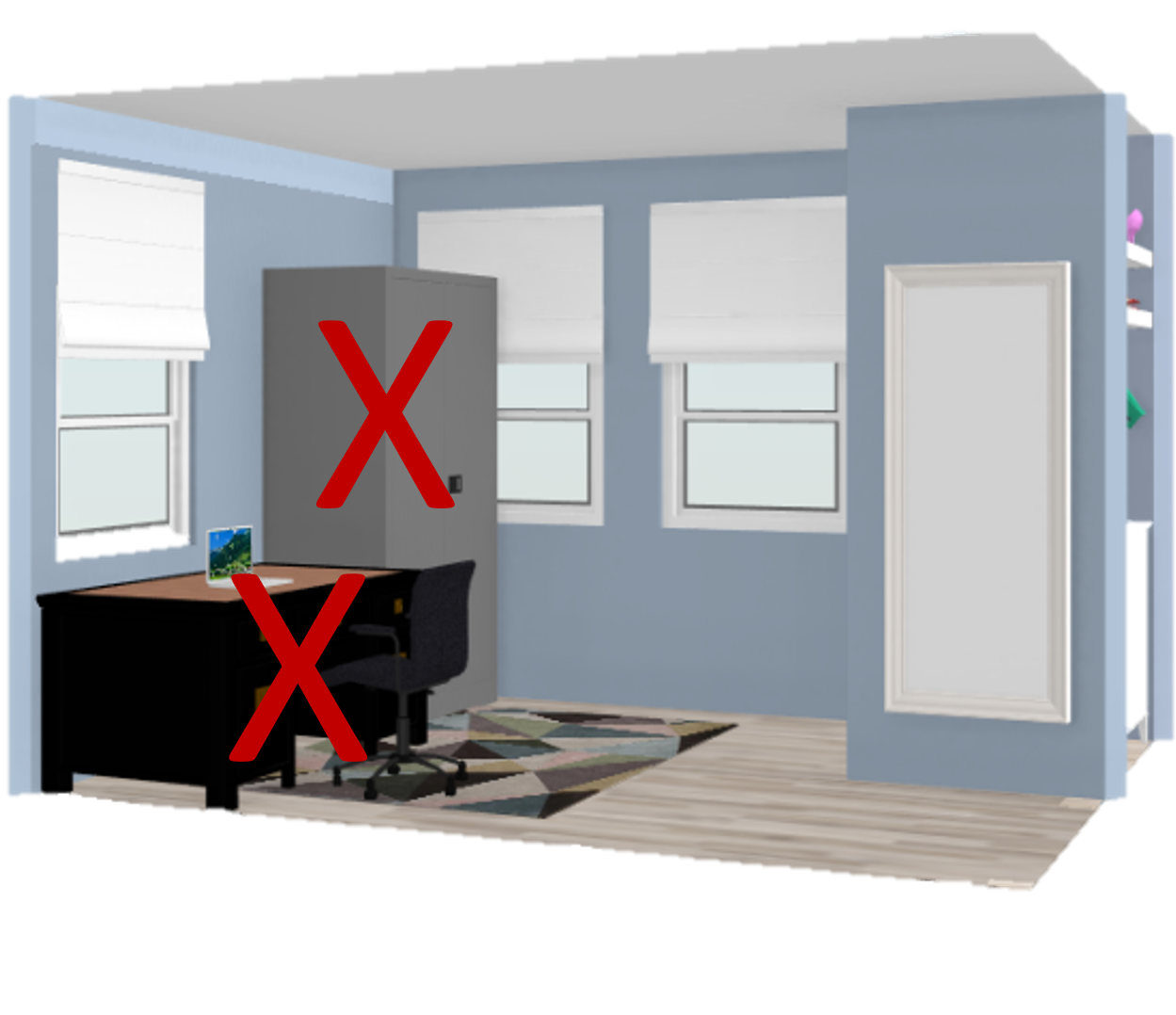Small rooms can be a challenge to arrange.
Add multi-function on top of that and, well that makes things way more complicated.
Suddenly there needs to be room for a few different activities in the small space.
This is especially common these days where we’re working from home, going to school on our computers and if you’re a small home dweller, these kinds of requirements are tough to satisfy.
Getting multiple uses out of the same small space doesn’t have to be hard.
When you get totally clear on how much time and space is spent on each activity, the ideas for how to layout the furniture almost becomes automatic. You begin to see exactly how much space each activity needs.
Although, with an office refurbishment service, you can design a versatile space that adapts to various needs. This ensures optimal functionality without compromising space efficiency.
Let me show you how to make a small multipurpose dressing, office craft room combo work.
Parameters:
Small room that must be a home office 3 to 5 days a week.
A dressing room everyday
And, a crafting space on the weekends.
So, this is a multifunctional space to say the least.
It helps to rank the importance of each function in order to get the best layout.
So,
Dressing room, happens every day.
Office, happens 3 to 5 days each week.
Crafting, happens 1 to 2 days each week.
The actual size is 10’ wide by 13’ long.
That does not include the corner closet that measures 4’ 9” wide by 3’ 5” deep, outside dimensions.
What that does is brings the room from 13’ down to 10’.
So, the usable space in the room is really just 10’ x 10.
Pathways
The first thing to do when figuring out a layout is to understand the pathways into and through the space.
Since the ‘everyday’ function of the room is to be a dressing room, the pathway to the closet, where the clothes are, needs to be kept clear.
The blue arrows show how she’ll move through the space. There should be nothing impeding that movement.
So, the swing of the doors is important to pay attention to.
Nothing should go behind or in front of them to limit their full swing.
Zones
We’ll call zone 1 the dressing room zone. It’s open so dressing in that area should be comfortable.
Zone 2 is where the balance of the functions needs to happen: office and crafting space.
Furniture Layout
Now, that balance of the room, around 60%, needs to accommodate the home office and the crafting activities.
Necessary Furniture
In this segmented area, there needs to be a desk for working. Storage for craft supplies and office equipment: printer, computer, maybe a router and modem.
It’s important not to overwhelm the area.
Adding in a big, bulky desk that’s closed up with doors and cabinetry will make the small space feel very congested.
Equally important, you don’t want to add tall, closed cabinets that will eat up more visual space either.
Not to mention, the placement of the windows makes adding tall cabinets difficult.
Now, I’m all for using vertical space in small rooms, but not at the expense of aesthetics.
Remember, this is a space she’ll spend pretty much everyday in.
It should feel comfortable and spacious, not clunky and cluttered.
So, before making decisions on the furniture placement in zone 2, it’s important to consider all the areas that need to be accessed.
She’ll need access to the windows everyday, even just to pull up the shades.
Just like doors, the windows shouldn’t have anything impeding their functionality.
Tall furniture that blocks access won’t work.
The pathway into the room needs to be clear.
That means furniture can’t go on the longest portion of wall in zone 1.
That limitation affects zone 2 as well because tall cabinets on this long wall will block the window and a desk along this wall would look awkward because it won’t be centered.
Anchor the Room
Most of the time I advise on placing the largest rug possible in small rooms.
Here, I wanted to make sure the threshold of the closet door in zone 1 would not be affected by a large rug, so placing an 8’ x 5’ rug was ideal.
That allows for whatever furniture will go on it to be completely on the rug and there is enough room around it for storage options like low shelves, credenzas or low cabinets.
Speaking of low cabinets, a couple of shallow, low cabinets placed side by side is the perfect storage option for craft and office supplies and for office equipment like a printer and other electronics that don’t need to be on display.
The cabinets are flat on the floor and off the rug.
The rug is far enough back so the closet door can open freely and all of zone 1 is open and passable.
I decided to go with a large, glass top desk. It’s the focal point, it’s the first thing you see when you walk into the room.
It’s accessible from the right or left.
The desktop is in line with the edge of the area rug, giving the chair plenty of room to push back and forth in front of the cabinets.
When she needs to access the cabinets, she’ll push the chair all the way in and the doors of the cabinets are clear.
The glass top keeps the visual field open and the desk itself is also an open- a writer’s style that has modern supports that aren’t closed off.
Since the desk is floating in the room, keeping it as visually open as possible will maintain the feeling of being uncluttered.
There are no cords on the desk, so the chandelier adds task and decorative lighting.
I placed a round table lamp behind the desk on the first cabinet to give the space more ambient lighting.
The desk does double duty as a work surface for her office, Monday through Friday.
Then it can be cleared easily for crafts on the weekend.
Tip: having the chandelier on a dimmer will allow her to adjust the intensity of the light depending on her activities.
A full-length mirror on the closet wall, next to the entrance, is a great spot. It’s out of the way, not reflecting into the space – who wants to stare at themselves when working, right?
To balance the single window in the corner, I added floating shelves above the second long cabinet for display and for holding anything functional or decorative.
I chose to keep the long wall as a spot for a large piece of art that ties in all the colors of the rug as a focal point.
I like using large art in small spaces because it adds instant drama and energy.
As we look at the space from above,
Zone 1 is completely free of obstruction and she can use this area easily to dress, which again is the everyday need.
The balance of the space is clean and uncluttered but super functional.
The laptop is charged on the cabinets behind when not in use and the desk is large but visually open as the perfect dual function surface for work and crafting
Everything that doesn’t need to be on display is housed inside the two cabinets that make the absolute most of the width of the room without feeling clunky.
Keeping the cabinets white stops them from feeling heavy.
It’s a great use of the space and all three necessary functions are accomplished.
There you have it, how to get 3 functions out of one small room.
I’d love to hear what you think of this post.
Leave me a comment below and tell me about your multipurpose rooms.
Did you have a hard time finding furniture that would fit and give you the requirements you needed?
What other purposes have you needed in your small home?
I’m all ears!
Join the Fun!
If you enjoyed this post and you want to keep seeing my weekly blog, the best way to do that is to subscribe.
You can subscribe by downloading my 11 Secrets Only Designers Know to Make Your Space Rock. If you’re curious about how decorators and designers make a home look magazine ready, you’ll love taking a gander at these 11 secrets. You’ll learn how to style your room from the floor up and it will work for ANY space you have.
I write about small space design and decorating, sustainable furniture options, positive self care and a variety of do-it-yourself home décor.
I’d love to connect with you!
“Michael Helwig was top-notch, very professional and responsive to my needs. He allowed me time to explore ideas and try out a variety of combinations until we found the perfect fit. Michael provided detailed information and offered beautiful ideas to make my dream living room become a reality. The furniture he sourced has totally transformed my living room space. Everyone that has seen my new living room has one word, WOW! A special thank you to Michael for a wonderful experience.”
“Michael was very knowledgeable and guided us, with great patience and good humor, through the process of designing our dining room and helping us find the perfect sleeper sofa. He offered really helpful advice when we asked questions - which was often - but at no time did we ever feel pushed. He helped me when I felt like I couldn’t make one more decision. When my new furniture finally arrived I realized everything down to the pillows was perfect. I couldn’t be happier!”
Michael is Principal designer and blogger at Michael Helwig Interiors in beautiful Buffalo, New York. Since 2011, he’s a space planning expert, offering online interior e-design services for folks living in small homes, or for those with awkward and tricky layouts. He’s a frequent expert contributor to many National media publications and news outlets on topics related to decorating, interior design, diy projects, and more. Michael happily shares his experience to help folks avoid expensive mistakes and decorating disappointments. You can follow him on Pinterest, Instagram and Facebook @interiorsmh.























